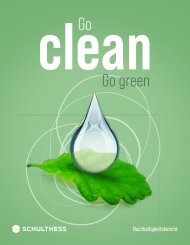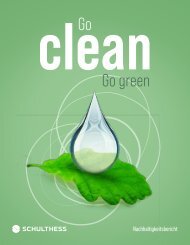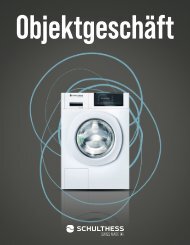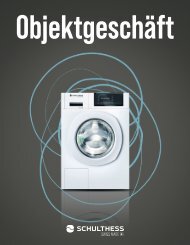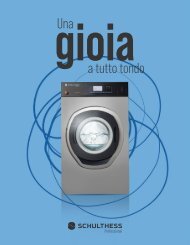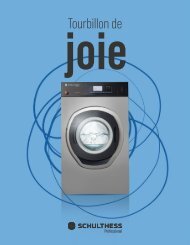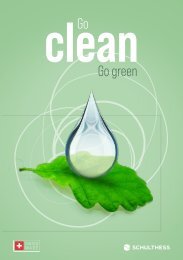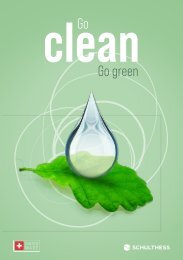Schulthess Nachhaltigkeitsbericht 2023
You also want an ePaper? Increase the reach of your titles
YUMPU automatically turns print PDFs into web optimized ePapers that Google loves.
Scope 1: Direct emissions<br />
The products category accounts, at 16 780 t CO2eq, for 84%<br />
of emissions. The majority of this is generated in the produc-<br />
Emissions from the provision of fresh water and the treatment<br />
of wastewater are in the per thousand range. The waste cat-<br />
Direct emissions t CO2eq<br />
1400<br />
1200<br />
1000<br />
800<br />
600<br />
400<br />
200<br />
0<br />
13,6<br />
12,2 12,3 12,3<br />
13,0<br />
2013 2014 2015 2016 2017 2018 2019 2020 2021 2022<br />
11,7<br />
11,0<br />
9,9 10,2<br />
8,0<br />
16<br />
14<br />
12<br />
10<br />
8<br />
6<br />
4<br />
2<br />
0<br />
t CO2eq per CHFm of revenue<br />
tion of raw materials in the upstream supply chains, and the<br />
relatively small proportion in the downstream transport and<br />
in the disposal of machines.<br />
The emissions in the mobility category are made up of direct<br />
emissions from the combustion of fuels on the one hand,<br />
and indirect emissions from commuting and business transport<br />
on the other. With a total of 1 295 t CO2eq, the mobility<br />
category accounts for around 6% of the footprint.<br />
The goods category contributes 1 609 t CO2eq to the footprint<br />
and includes the auxiliary materials and consumables in production<br />
in Wolfhausen as well as the commercial products<br />
egory includes the emissions generated during the processing<br />
of the waste produced at the Wolfhausen plant.<br />
The use phase of our products causes an estimated 200 000 t<br />
of CO 2<br />
. The emissions in this category come from the production<br />
and provision of electricity and water for the operation<br />
of <strong>Schulthess</strong> machines and are largely dependent<br />
on whether the electricity comes from renewable or fossil<br />
sources. The use phase is not part of the system under consideration.<br />
that <strong>Schulthess</strong> distributes.<br />
Heating oil consumption<br />
Gas consumption<br />
Fuel consumption<br />
t CO2eq per CHFm of revenue<br />
The energy category (262 t CO2eq) includes on the one hand<br />
the direct emissions from the combustion of regular fuels<br />
(182 t CO2eq), and on the other hand the upstream indirect<br />
emissions (80 t CO2eq) necessary for the production of pur-<br />
i<br />
In Scope 3, those categories were sur-<br />
chased energy and for the production of regular fuels.<br />
41%<br />
less CO₂ emissions from<br />
combustibles and fuels<br />
compared to 2013<br />
veyed that are necessary for direct operational<br />
work and can be directly influenced<br />
in the short and medium term.<br />
The categories lessees, processing of<br />
sold intermediate products, franchises<br />
and investments were not<br />
taken into account. In addition,<br />
the indirect emission sources<br />
that are absolutely necessary,<br />
such as production machines<br />
and office equipment, were not<br />
surveyed.<br />
To make the results more accessible,<br />
the various direct and indirect<br />
emission sources were assigned to the<br />
Scope 3 emissions<br />
Use phase:<br />
up to 200 000 t CO2eq.<br />
By far the largest<br />
share of emissions,<br />
over 90%, comes<br />
from the use<br />
of products sold.<br />
categories energy, goods, products,<br />
water, mobility and waste.<br />
Energy 262 t CO2eq, 1% Mobility 1 295 t CO2eq, 6%<br />
Waste 32 t CO2eq,





